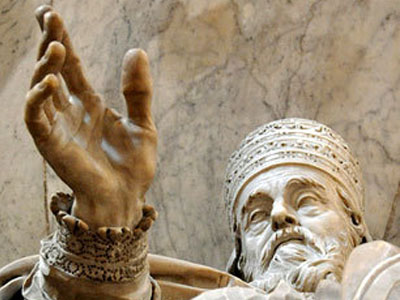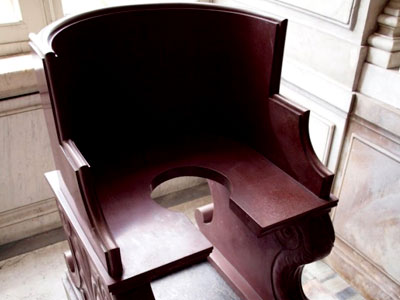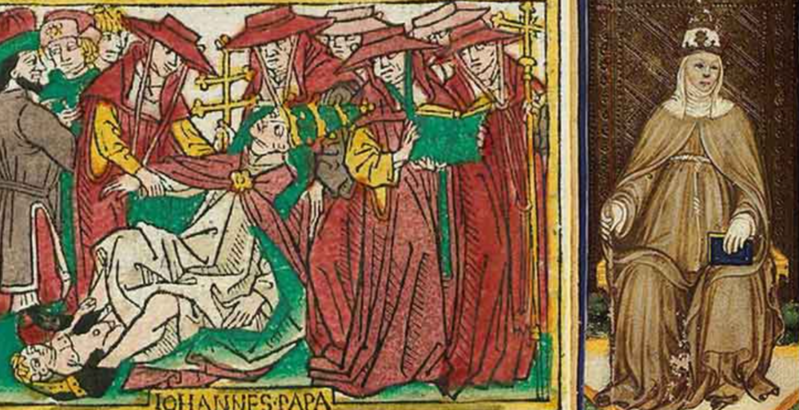Upon his election, Pope Leo XII announced, "You are electing a dead man!" Although a man of poor health, he was an active pope for a few years until his death in 1829.
 Upon entering St. Peter's Basilica, the first monument on your right (on the way from the Chapel of the Pieta’ to the Chapel of St.Sebastian) is the tomb of Pope Leo XII (1823-1829).
Upon entering St. Peter's Basilica, the first monument on your right (on the way from the Chapel of the Pieta’ to the Chapel of St.Sebastian) is the tomb of Pope Leo XII (1823-1829).
Made famous at the beginning of his pontificate, he pointed out to the cardinals that they had made a huge mistake by electing him as he was a man of a poor health - ready to leave the kingdom of earth rather than rule it.
He announced: "You are electing a dead man!".
Against the odds, Leo lived a couple of years as an active pope, drearily fighting the ecclesiastic bureaucracy. Leo was not the oldest nor the sickest pope to be elected. In his illness soon he was surpassed by Urban VII who died of malaria just 13 days after his election.
Adrian I is proudly named the oldest cardinal to become a pope. Elected at the age of 80, he died in 795 at the age of 95. Far worse than age and illness, John XII (937-964) was named the worst pope in history (even the notorious Borgia Pope Alexander VI didn’t beat him!).
It is rumored that on every possible occasion he evoked demons, committed several acts of adultery and during mass liked drinking a toast to the devil!
Pope John XII was rumored to be an adulterer, often invoking demons and even liked drinking a toast to the devil during mass.Another John but this time John II (533-535), was the first pope in history to change his name.
Have you ever wondered what the purpose of new elected popes changing their names is?
In the case of John II, his birth name was Mercurius, obviously coming from the name of the pagan god Mercury which didn’t seem too appropriate for the name of a pope.
The tradition continued and the change of name became also a symbol of a new life of the newly elected pope.
These days, popes decide to take a new name after their favorite saint or to honor their predecessors (in case of John Paul II and Benedict XVI).
Pope John Paul I was the first pope to pick not one but two names after previous popes: John XXIII who had nominated him a bishop and Paul VI who had nominated him a cardinal.
Nowadays after conclave, every newly elected Pontiff is asked by the Cardinal Dean what he wishes to be named and if he accepts his new function.
The Conclave,  where the pope is elected, holds centuries of rituals, traditions, and most fascinating...secrets!
where the pope is elected, holds centuries of rituals, traditions, and most fascinating...secrets!
The next secret won’t be found in any official Vatican book.
The most harmful and embarrassing object that was used during the conclave is the Sedia Stercoraria.
The unusual and embarrassing object that was used during the conclave is the Sedia Stercoraria (the pierced chair) and it’s supposed to be kept in the darkest place of the Vatican Museums not opened to public.
The ritual of testing the gender of the new pontiff by placing him on a tall chair that has a hole instead of a seat has a very rich tradition. In 855, some scholars believe a woman named Joan dared to falsify her gender and was nominated as Pope John VIII.
As the story goes, no one was aware of her “double identity” until her death when one of the doctors examined her body and discovered that not only she was a woman but a pregnant woman!
Scandal was in the air, so to prevent any kind of misleadings the cardinals came up with a very simple method to make sure that pope is a man.
After the election the new pontiff needed to prove that he had, let's say, the 'proper equipment' to be a pope. Each pope has to sit on the chair, while one of the cardinals would quickly examine the situation by taking a peek below.
As the story goes, if everything is ok, the cardinal says, "He has two balls, and they are well hung!” bringing a cheerful smile on other cardinals' faces.

The case of the woman-pope Joan was naturally erased from the Vatican’s history just like the presence of wives of some popes who actually lived with them in the palace.
The last pontiff to be married was Adrian II (867-872).
Celibacy is a concept that was brought to the Catholic Church in the 12th century at the First Lateran Council (1123). Around 25 popes were married (including St. Peter).
Celibacy in early Christian times was not mandatory but highly recommended for all the clergy to keep their mind free of all human troubles and more as a form of discipline than a doctrine.
Wish to see the famous "Sedia Stercoraria"? Our Vatican Museums and Hidden Gems Private Tour is what you need!
If you'd love to know more curiosities about the Popes, you should definitely book one of our Rome Private Tours!


